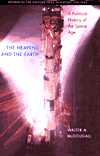|
555 pgs, 1997, Johns Hopkins University Press
ISBN 978-0801857485 McDougall's 1986 winner of the Pulitzer Prize for History presents the U.S., Soviet and European space programs as a comparison of public policy. He taps into declassified material, archives and published literature and interviews key participants in the historical space missions from Sputnik I to Apollo 11 to give the full picture of the space race, and point out the relationship between political leadership and technological development.
TABLE OF CONTENTS Part I -- The Genesis of Sputnik
- The Human Seed and Social Soil: Rocketry and Revolution
- Political Rains and First Fruit: The Cold War and Sputnik
Part II -- Modern Arms and Free Men: America Before Sputnik
- Bashful Behemoth: Technology, The State, and the Birth of Deterrence
- While Waiting for Technocracy: The ICBM and the First American Space Program
- The Satellite Decision
Part III -- Vanguard and Rearguard: Eisenhower and the Setting of American Space Policy
- "A New Era of History" and a Media Riot
- The Birth of NASA
- A Space Strategy for the United States
- Sparrow in the Falcon's Nest
- The Shape of Things to Come
Part IV -- Parabolic Ballad: Krushchev and the Setting of Soviet Space Policy
- Party Line
- The Missile Bluff
- Hammers or Sickles in Space?
- Space Age Communism: The Krushchevian Synthesis
Part V -- Kennedy, Johnson, and the Technocratic Temptation
- Destination Moon
- Hooded Falcons: Space Technology and Assured Destruction
- Benign Hypocrisy: American Space Diplomacy
- Big Operator: James Webb's Space Age America
- Second Thoughts
Part VI -- The Heavens and the Earth: The First Twenty-five Years
- Voyages to Tsiolkovskia
- The Quest for a G.O.D.
- A Fire in the Sun
|

